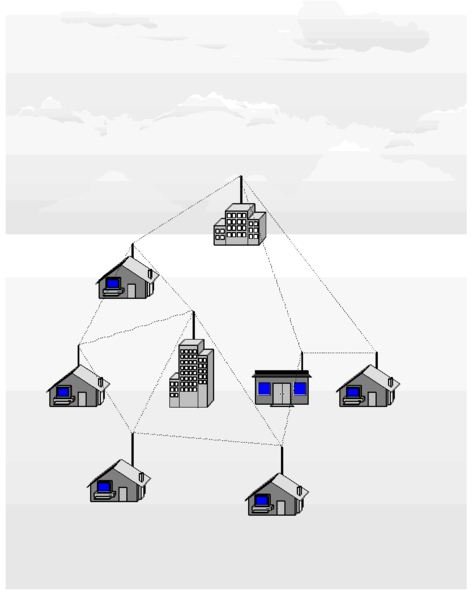What is a Wireless Mesh Network (WMN) and How Does it Work?
What is a Wireless Mesh Network (WMN)
Existing wired or fixed wireless networks allow users to connect to access points (APs) that are actually wired to the Internet. The more users connect to an AP, the slower the connection. The term “wireless” takes on an actual meaning when it refers to wireless mesh networks.
The wireless mesh network (WMN) is a system that connects users in proximity through high-frequency radio waves instead of cables. The WMN uses a large number of wireless mesh nodes that are actually radio devices (transmitters and receivers) to establish a high-bandwidth network connection where users are able to route their connections through other users’ computers, in order to locate the highest speed channels.
Design and Operation of Wireless Mesh Networks
In a wireless mesh network, only one of the network nodes needs to be directly connected or wired to an Internet modem. This node will then share the connection with the closest nodes wirelessly. These nodes will then take their turn and spread the connection to the ones near them, etc. The only wiring each node will require is the power supply. In this way the connection can be geographically expanded without any physical limits, as long as there available nodes in the area. These nodes use the necessary software that enables them to interact with the others and at the same time use a process called dynamic routing to locate the fastest path available for the Internet connection to be established. The more nodes installed, the faster the connection.
There are two types of network nodes used in a WMN: mesh routers and mesh clients.
Conventional and mesh routers are basically the same as far as their hardware is concerned. However, mesh routers differ from the conventional wireless routers in that they require much less transmission power to cover the same area and the medium access control (MAC) protocol used is enhanced with better scalability in a multi-hop mesh environment.
Mesh clients, on the other hand, have the ability to operate as mesh routers as well. However, gateway or bridge functions do not exist in these nodes. The hardware platform and the software of the clients are much simpler than the routers (only one wireless interface needed). What’s more, mesh clients can exist in a higher variety of devices such as laptops/desktops PCs, Pocket PCs, PDAs, RFID readers, IP phones, etc.
The WMN architecture described may provide a high-broadband network suitable for a neighborhood, campus, or city installation. It will provide coverage to areas between the houses, and users may choose multiple connection paths instead of a single path- as is the situation today- and gateways will be able to be set up for multiple homes, thus reducing costs.
Schematic of a Wireless Mesh Network in a City-wide Deployment
Types of WMNs
There are three types of WMNs depending on the functionality of the nodes:
- Infrastructure or Backbone WMN: This type of network uses mesh routers to interconnect the mesh clients, thus forming an infrastructure or backbone for clients. This is the most commonly used type of WNM today. The routers of this network can be used for backbone as well as user communication. The mesh backbone communication can be achieved with the use of long-range directional antennas. The mesh user communication can be achieved by placing routers on top of house roofs to serve as access points (APs) for the neighborhood or the nearest community.
- Client WMNs: This type of network consists only of mesh clients that perform all the necessary functions such as routing without the aid of mesh routers. A packet of data in this case hops through a number of network nodes until it reaches the destination node.
- Hybrid WMNs: This is a combination of the two types of WMNs: infrastructure and client mesh networks. Clients may connect directly to other mesh clients or through mesh routers. This kind of WMN is expected to be most widely used in the future.
Advantages of WMNs
Wireless mesh networks require low expenditure due to the limited use of cables needed to establish the network and the use of the same technology used as fixed wireless networks (same Wi-Fi standards, 802.11a, b and g).
They allow higher speeds, extended geographic coverage and less radio interference, higher bandwidth and less network congestion. Contrary to the conventional wireless networks where users share the bandwidth, the more the users or nodes the faster and more stable the connection will be. Wireless mesh nodes are easy to install (streetlights, rooftops, traffic signals, and road signs) making it easy for a network to be expanded.
These mesh networks are self-configuring and self-healing meaning that the existing network can automatically incorporate a new node and locate the fastest path to send data in case the usual path is blocked. This feature makes the mesh network ideal in case of a natural disaster or power failure in the vicinity nodes.
Wi-Fi Antennas Placed across a Metro Area to Create a Wireless Mesh Network

Final Remarks
Apart from the average user benefits, WMNs have to offer many benefits in the fields of services and business. Large cities such as New York, London, and Las Vegas are actually at the point of establishing large area WMNs in the attempt to raise their international competitiveness. Other cities are soon to follow.
Sources:
- Science Daily: Computer Engineers Improve Wireless Networks by Making Users Connect Through Each Other
- “Business Opportunities and Considerations on Wireless Mesh Networks” (PDF): G.Vasilakis, G. Perantinos, I.G. Askoxylakis, N.Mechin,V.Spitadakis, A.Traganitis
- “Wireless mesh networks: a survey”, I.F. Akyildiz , X.Wang, W. Wang, Computer Networks, 2005
